Don't wanna be here? Send us removal request.
Text

Skeleton recovered from the Le Lanchon experiments on human evolution. In these tests, volunteers were subjected to procedures to "accelerate the development of mankind". No subject is recorded to have survived. Their crab-like form is thought to be an instance of carcinization.
4K notes
·
View notes
Text
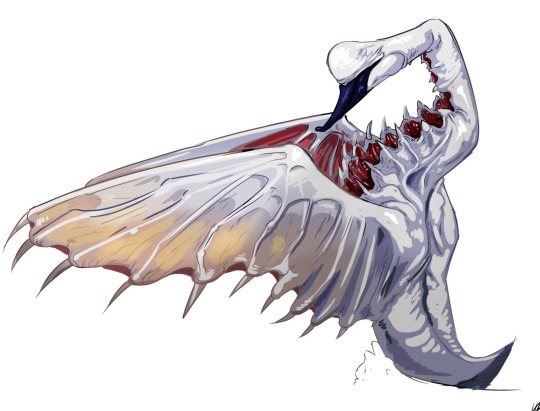
The Mock Swan
no eyes, "beak" is a sensory organ that seems to act a little like a platypus being able to hunt by electric signals. plunges into prey and drains them off all their blood, turning red. tend to hide among real swans as camouflage. real swans seem scared of them though.
skin has no feathers, is rubbery and fleshy, slightly sticky, the bones are cartilage and prone to snapping if gripped. someone made them on purpose.
695 notes
·
View notes
Text
This jelly is ear-resistable!

In the lunar calendar, we’ve entered the Year of the Rabbit—a time of hope, peace, and prosperity. If you hop into the ocean looking for some bunny to love, you’re in luck! There are huge algae-eating California sea hares that release magenta ink when they’re disturbed and cute black-and-white sea bunny nudibranchs that feast on sponges.
Our new favorite? The rabbit-ear comb jelly (Kiyohimea usagi), a delicate deep-sea ctenophore that lives in Monterey Bay! Scientists named it usagi—Japanese for “rabbit"—because little projections on its body look like rabbit ears. Want to learn a hare more about the rabbit-ear comb jelly? Check out this video from @mbari-blog! https://mbayaq.co/3Y4itfJ
905 notes
·
View notes
Video
youtube
This jelly-like animal fishes for its meals.
Siphonophores are close cousins of jellies. They’re fragile creatures composed of individual, specialized parts connected to each other in a chain. Some parts pulse and steer the colony, others stun and ingest prey. Siphonophores thrive in the midwater where there aren’t any sharp surfaces to damage their delicate bodies. MBARI’s remotely operated vehicles, or ROVs, have revealed a surprising diversity of siphonophores in Monterey Bay and we’ve learned they’re important predators in the ocean’s depths.

We’ve discovered several remarkable new siphonophore species, including this especially cunning predator—the angler siphonophore, Erenna sirena. In a dazzling display of predatory prowess, it dangles luminescent lures that mimic crimson crustaceans and attract unsuspecting fishes. Zap! When a curious lanternfish gets too close, the siphonophore’s tentacles deliver a powerful sting and snare a meal.
115 notes
·
View notes
Video
youtube
Meet a deep-sea escape artist.
When danger approaches, the silky jelly,
Colobonema sericeum
, uses speed and clever tricks to avoid being eaten. As they make a quick exit, they drop sticky tentacles to confuse potential predators. We have seen silky jellies with tentacles of varying, uneven lengths. This suggests that
Colobonema
can grow back their lost tentacles. Silky jellies are abundant in Monterey Bay, but only between 200–700 meters (660–2,300 feet).

We have recorded an extensive archive of deep-sea video that offers insight into more than just animal behavior. Our researchers use this trove of data to understand long-term trends in populations of midwater animals. Comparing thousands of observations of deep-sea jellies reveals how their populations ebb and flow over time.
During warm El Niño events, they become scarce. As climate change alters the ocean, what will the future look like for Colobonema? We worry they will get squeezed into a smaller and smaller range.

Animals of the deep have built remarkable strategies to thrive in the ocean. But even an escape artist like Colobonema cannot outrun the impacts of climate change. We must act quickly to ensure the future of these denizens of the deep. Understanding how our actions affect the ocean and Earth’s climate is critical. Share what you have learned and help us grow our community of ocean champions. Learn more about these delicate drifters on our website.
188 notes
·
View notes
Video
tumblr
It’s been a while since we supplied some serious squeee! 🥰🤗
Also known as the tadpole snailfish, the scientific name for this species, Nectoliparis comes from the Greek words nekton (meaning swimmer) and liparos (meaning fat). This tiny snailfish was captured on camera by the ROV Doc Ricketts at 575 meters (nearly 1,890 feet) deep. Adults of this species only grow to a length of up to 6.5 centimeters (just about three inches) and have been observed as deep as 3,383 meters (nearly 11,100 feet).
263 notes
·
View notes
Video
tumblr
Comb jellies—also known as ctenophores—come in a wide range of shapes and sizes. Many are transparent, but some deep-sea species, like the abyssal comb jelly, Beroe abyssicola, are ruby red or deep purple in color. So far, scientists have described approximately 200 ctenophore species.
Comb jellies swim by flicking hair-like ctenes back and forth. When the lights of our submersibles illuminate an abyssal comb jelly, the ctene rows diffract the light into the colors of the rainbow, creating those dazzling disco lights.

Most animals in the midnight zone produce bioluminescence. The abyssal comb jelly has a scarlet stomach that absorbs the light produced by meals digesting in its gut. The red pigment absorbs blue-green bioluminescence, keeping Beroe hidden from predators. Many other deep-sea jellies employ a similar strategy. Learn more about these dazzling denizens of the deep on our website.
351 notes
·
View notes
Video
tumblr
The big red jelly, Tiburonia granrojo, is one of MBARI’s biggest discoveries, literally.
At one meter (about three feet) in diameter, a big red jelly is too big to collect to study in the laboratory. Instead, MBARI’s video observations have been invaluable in building our understanding of this species.

Unlike most jellies, the big red jelly doesn’t trail thin tentacles behind its bell. Instead, it has four to seven fleshy oral arms that dangle below to help capture food. Batteries of stinging nematocysts cover the surface of these jellies. Their tiny harpoon-like cells stun prey—though we’re still not sure what this species eats.
Historically, scientists had to rely on trawl nets to sample the deep sea, but delicate jellies turn to mush when they’re dragged up to the surface in a net. Robotic submersibles have allowed MBARI researchers to observe these fragile creatures in their natural environment and document the stunning diversity of gelatinous animals in the deep sea. Learn more about these remarkable residents of the deep on our website.
286 notes
·
View notes
Photo







A snake story, based on an experience I had while I was in Florida.
311K notes
·
View notes
Video
tumblr
Comb jellies—also known as ctenophores—come in a wide range of shapes and sizes. Many are transparent, but some deep-sea species, like the abyssal comb jelly, Beroe abyssicola, are ruby red or deep purple in color. So far, scientists have described approximately 200 ctenophore species.
Comb jellies swim by flicking hair-like ctenes back and forth. When the lights of our submersibles illuminate an abyssal comb jelly, the ctene rows diffract the light into the colors of the rainbow, creating those dazzling disco lights.

Most animals in the midnight zone produce bioluminescence. The abyssal comb jelly has a scarlet stomach that absorbs the light produced by meals digesting in its gut. The red pigment absorbs blue-green bioluminescence, keeping Beroe hidden from predators. Many other deep-sea jellies employ a similar strategy. Learn more about these dazzling denizens of the deep on our website.
351 notes
·
View notes
Video
tumblr
The most terrifying thing in the deep sea. 😱
The human imprint of pollution is now evident in all marine ecosystems, including the deepest parts of our ocean. The impacts of deep-sea trash are magnified by the near-freezing water, lack of sunlight, and low oxygen concentrations that discourage the growth of bacteria and other organisms that can break down debris. Under these conditions, our garbage might persist for decades.
212 notes
·
View notes
Photo
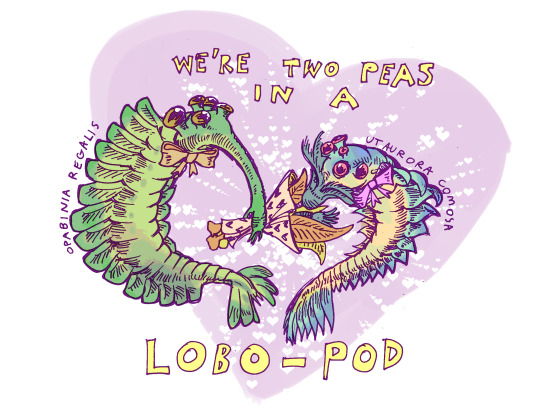
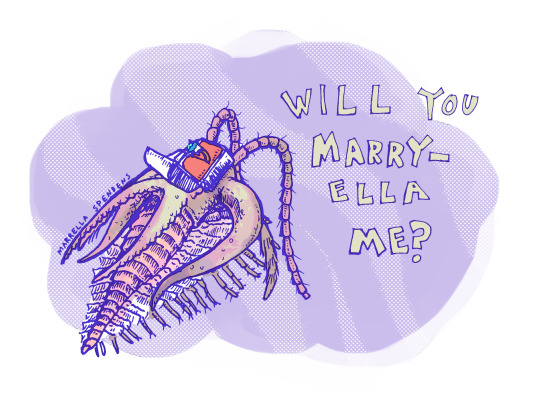
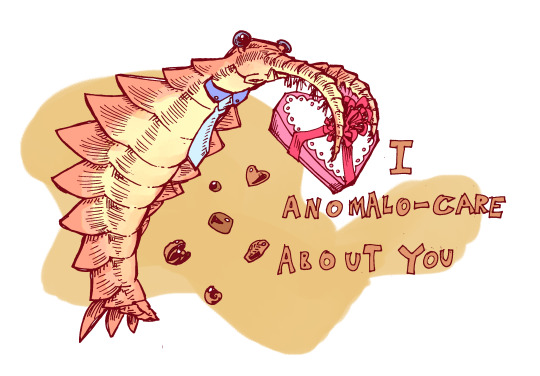

Happy Valentine’s Day- Show your friends that your feelings will NEVER go extinct with some cambrian critters.
19K notes
·
View notes
Video
tumblr
Meet the octopus squid, Octopoteuthis deletron. 🐙🦑
Unlike most other squids, the octopus squid only has eight arms (like its octopus relatives). These arms are bioluminescent, with light-producing organs, or photophores, at the end of each arm.
The octopus squid also has a fascinating way of protecting itself when threatened by predators. Like a lizard that detaches its tail when attacked, this squid can drop its bioluminescent arm tips, leaving a wiggling arm with a flashing photophore in the grasp of a confused would-be predator. As far as we know, it’s the only squid species to exhibit this unusual defensive behavior.
1K notes
·
View notes
Video
tumblr
Deep-sea double helix 🧬
Salps are gelatinous invertebrates that live in the open ocean but are closely related to the “sea squirts” (tunicates) seen in tidepools. They are found abundantly throughout the world’s ocean. Salp species in the genus Helicosalpa are among the most rarely observed and collected salps. This species, Helicosalpa virgula, was captured on camera by our remotely operated vehicle (ROV) Doc Ricketts at 282 meters (925 feet) deep.
421 notes
·
View notes
Video
tumblr
Deep-sea double helix 🧬
Salps are gelatinous invertebrates that live in the open ocean but are closely related to the “sea squirts” (tunicates) seen in tidepools. They are found abundantly throughout the world’s ocean. Salp species in the genus Helicosalpa are among the most rarely observed and collected salps. This species, Helicosalpa virgula, was captured on camera by our remotely operated vehicle (ROV) Doc Ricketts at 282 meters (925 feet) deep.
421 notes
·
View notes
Text
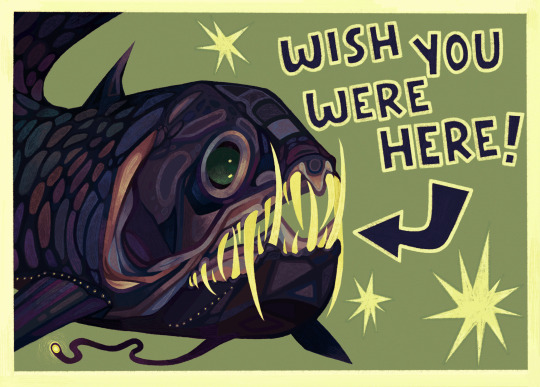
come for the light, stay because i won't let you go!
25K notes
·
View notes
Video
tumblr
Not your average feather boa. 😮
This siphonophore, Erenna richardi, can be identified by the massive clusters of tentilla (the side branches of the tentacle) at the end of the tail (siphosome). In Monterey Bay, this species has been observed at average depths of about 1,100 meters (3,600 feet).
These siphonophores are armed with a battery of powerful stinging tentacles, and researchers have seen them ensnaring fish just above the seafloor. Historically, gelatinous animals have been challenging to study. Their delicate nature makes them difficult to collect, especially from the ocean’s depths. By using deep-diving robots—remotely operated vehicles, or ROVs—MBARI and our collaborators are revealing the dazzling diversity of delicate drifters that lies beneath the surface. Learn more about the glorious group of siphonophores on our website.
594 notes
·
View notes